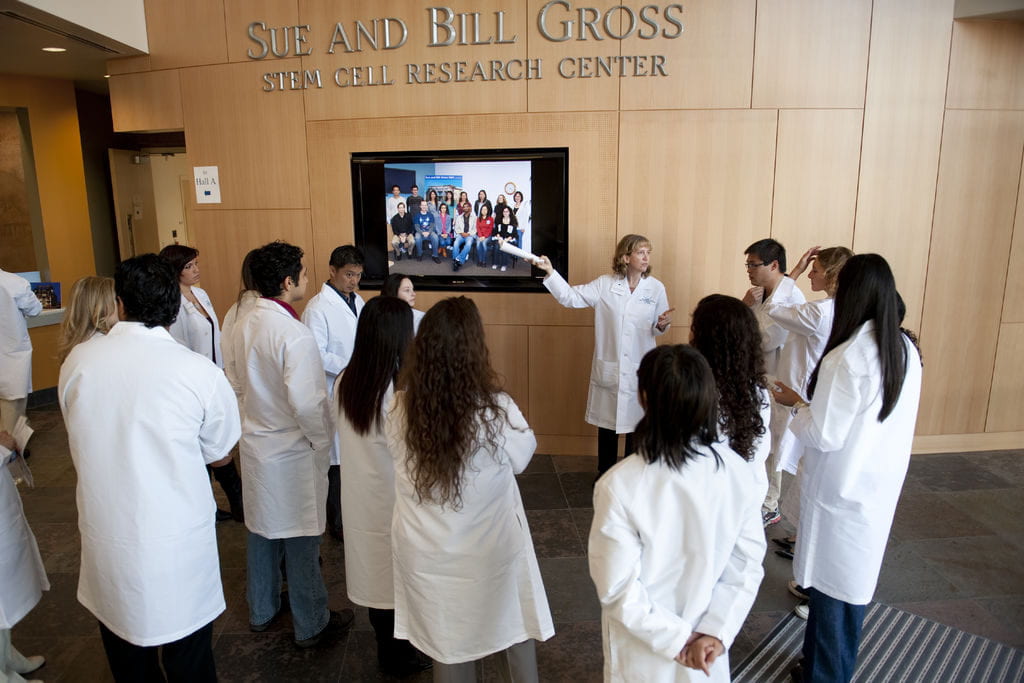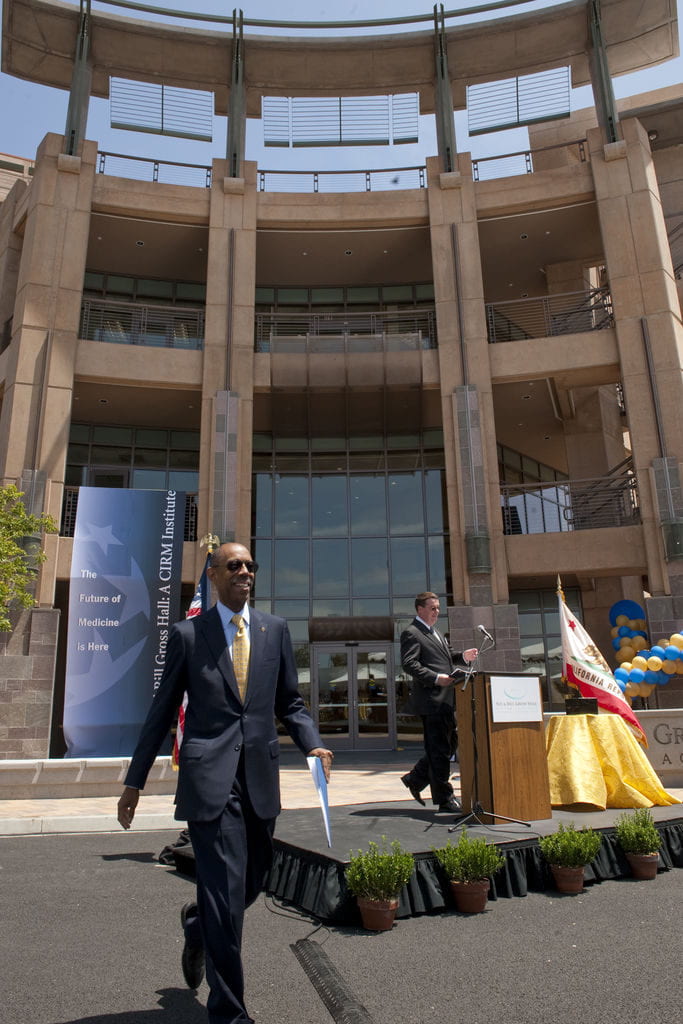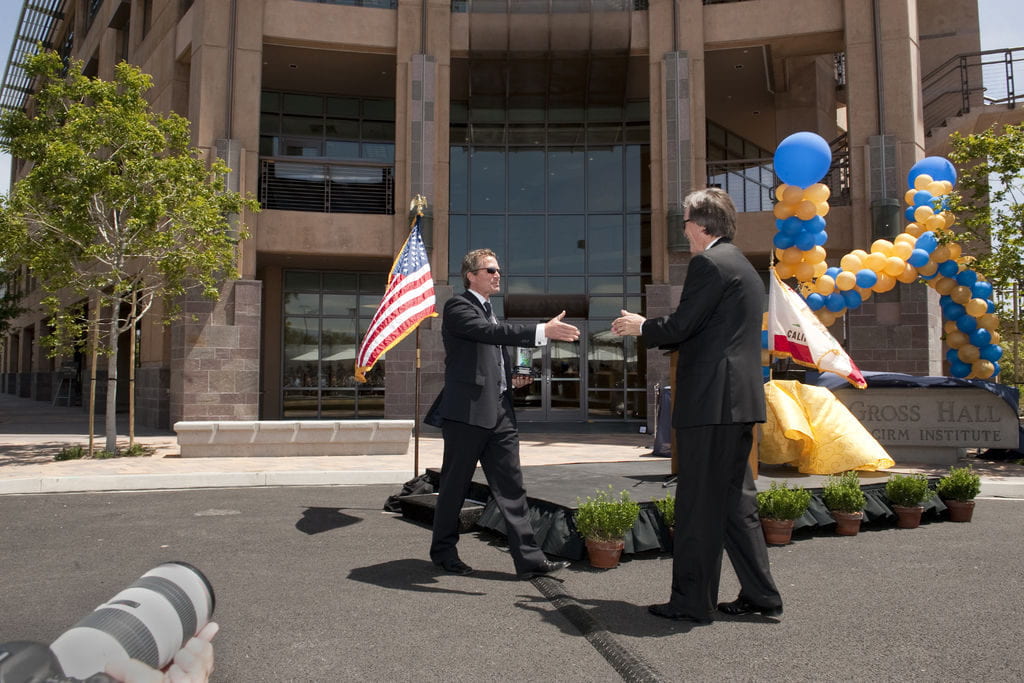New stem cell building a hub of hope, healing
Dedication of UCI’s Sue & Bill Gross Hall is milestone in effort to unlock stem cells’ potential and marks a milestone for the future of medicine.
What excites Nan Luke about the new Sue & Bill Gross Hall: A CIRM Institute at UC Irvine isn’t the spacious clinic or pristine laboratories, offices and meeting rooms. It’s the interaction that will take place there between patients like herself and researchers. Both are driving the effort to see if and how stem cells can treat a host of human diseases, disorders and injuries.
Dedicated May 14, the institute will serve as a hub for stem cell research and education in the region and house the Sue & Bill Gross Stem Cell Research Center. The $80-million, 100,000-square-foot building was designed to facilitate contact between patients in the first-floor clinic and rehabilitation center and stem cell researchers in first-, second- and third-floor labs.
“As a multiple sclerosis patient and advocate, I’m extremely heartened that every day, when researchers come to work, they’ll see what’s happening in the clinic and be reminded of what’s at stake,” says Luke, an Irvine attorney and board member of the National Multiple Sclerosis Society’s Pacific South Coast chapter. “It’s also exciting for the patients, who will feel, ‘Wow, we’re here all together in this new facility, and we matter.’”
UCI scientists have been striving to unlock the potential of stem cells for more than 30 years. Today at least 60 campus researchers in medicine, biology, engineering and other disciplines work collaboratively to advance stem cell research and teaching. They’ve made the university an international leader in the field, offering hope to millions who suffer from about 70 conditions stem cells may be able to treat.
The centerpiece of their efforts is Sue & Bill Gross Hall, the result of a successful public-private partnership to transform modern medicine. CIRM — the California Institute for Regenerative Medicine, created in 2004 through Proposition 71 to fund stem cell research — allocated $27.2 million to the project. Laguna Beach philanthropists Sue and Bill Gross made an initial $10-million gift that the campus leveraged to attract CIRM support.
“It’s fantastic that we’ve moved ahead so quickly,” says Peter Donovan, director of the Sue & Bill Gross Stem Cell Research Center. “Historically, UCI has had a tremendous research faculty and environment for collaborative work in regenerative medicine. We know stem cell research represents hope to millions of people, and we aspire to fully deliver on its potential.”
UCI’s recent stem cell efforts include:
- A pioneering therapy developed by renowned neuroscientist Hans Keirstead that restores bodily function lost to spinal cord injury, which could form the basis of the first federally approved embryonic stem cell clinical trial in humans;
- Research led by Frank LaFerla, Institute for Memory Impairments and Neurological Disorders director, showing for the first time that neural stem cells rescue memory in mice with advanced Alzheimer’s disease;
- Molecular biologist Tom Lane and colleagues’ exploration of stem cells’ utility in regenerating MS-ravaged nerve tissue;
- Development of new human stem cell lines by neurobiologist Leslie M. Thompson to better understand and treat Huntington’s disease.
Fueling this work are the input and encouragement of people like Luke, a member of the Sue & Bill Gross Stem Cell Research Center’s patient advocacy committee — a group of nine Orange County residents who either suffer from a disease or have a family member who does.
“What fills me with hope about stem cells is that the research deals with the basics of the human body and can be applied to different illnesses and injuries,” says Luke, who has had MS for 20 years. “I’m excited knowing a finding that improves the quality of life for someone with a spinal cord injury could possibly help people with MS or Parkinson’s.”
“The advocates keep us focused on what this is all about,” says Susan V. Bryant, vice chancellor for research and a member of CIRM’s governing board. “They’ve been very influential and have positively changed our approach to translating our research into potential therapies. Once you make that connection with the advocacy community, it’s impossible not to take it into account. You want to buckle down and keep pushing.”


